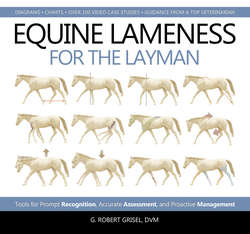Читать книгу Equine Lameness for the Layman - G. Robert Grisel DVM - Страница 36
На сайте Литреса книга снята с продажи.
4 The Art of Seeing Lameness
ОглавлениеForemost, we should consider the basic rationale behind why horses limp. Is it pain? Is it some biomechanical restriction that prohibits normal movement? Pain might be an inciter in some instances, but the uncomfortable horse actually limps in an attempt to avoid pain. The resulting gait abnormality, therefore, is a voluntary action executed by the horse to circumvent the problem as opposed to an involuntary product of the problem. This is an important distinction, because as observers we don’t directly appreciate the source of the horse’s pain. Rather, we see how the horse alters its movement to escape it.
Visual assessment of the horse’s physical adjustments relies on the art of pattern recognition, which is relatively simple once we know where to look, when to look and what to look for. This concept is familiar to us, because all of us practice pattern recognition in one form or another in our daily activities/jobs. Horse trainers, for instance, regularly evaluate recurring patterns of body language expressed by riders, both correct and incorrect. Farriers, on the other hand, are accustomed to interpreting various patterns of hoof wear. In all cases, abnormal patterns can give us insight with regard to what might be going on behind the scenes. With practice, we will learn to use our pattern recognition skills to depict visual markers of lameness that were previously imperceptible.
• In the case of pain-mediated lameness, we perceive adjustments that the horse makes in an attempt to avoid pain.
• In the case of biomechanical lameness, we perceive adjustments that the horse makes in an attempt to accommodate a physical restriction or exaggeration in movement.
• In the case of neurologic lameness, we perceive adjustments that the horse makes in an attempt to maintain balance.
Improved pattern recognition enables:
Owners to recognize lameness in their horses more quickly.
Veterinarians to assist in owner recognition of lameness more quickly.
Veterinarians to more accurately classify and characterize lameness during clinical examination, thereby streamlining the diagnostic process.
Let’s imagine for a moment that a horse’s lame limb would visibly change color for us, making it much easier to distinguish it from the other limbs. Most of us have had the ability to discriminate between colors since childhood, so this scenario would make determining the horse’s affected limb a breeze.
Now let’s imagine that the affected half of the limb (upper or lower) would glow brightly for us. In addition to seeing the affected limb, we would instantly know which aspect of the limb harbored the problem.
Finally, imagine that the specific source of the horse’s lameness (such as a certain joint) would flicker for us. In this instance, we could determine the source of the problem simply by looking at the horse. Visual lameness assessment of the horse would accordingly seem much less intimidating to the average observer.
Obviously, we don’t have the luxury of using colors and flickering lights to help us determine the anatomic source of a horse’s lameness. There are other visual markers, however, that can be just as obvious and just as definitive. It is the goal of this book to make the reader aware of these markers as well as their physiologic implications. The fundamental methodology of proper lameness assessment is highlighted in Figure 4.1 and detailed in section VI (see p. 157) of this book.
4.1 Basic Method of Visual Assessment
A. Initially, you scrutinize the adjustments the horse makes in its median anatomy to avoid or accommodate the problem. The visible expression of these adjustments helps you to identify which region(s) or limb(s) might be afflicted. In this instance, the right forelimb is lame.
B. Next, you determine the nature of the horse’s lameness. This can help you to discriminate which aspect of the region or limb is likely harboring the problem. In this example, the horse exhibits a combination lameness that suggests that the problem likely resides within the mid-aspect of right forelimb.
C. Finally, you can use the horse’s display of characteristic or unique gait deficits to establish a list of potential causes for the lameness. Based on the appearance of this horse’s combination lameness, for instance, you might suspect a problem along the right fore fetlock region.
